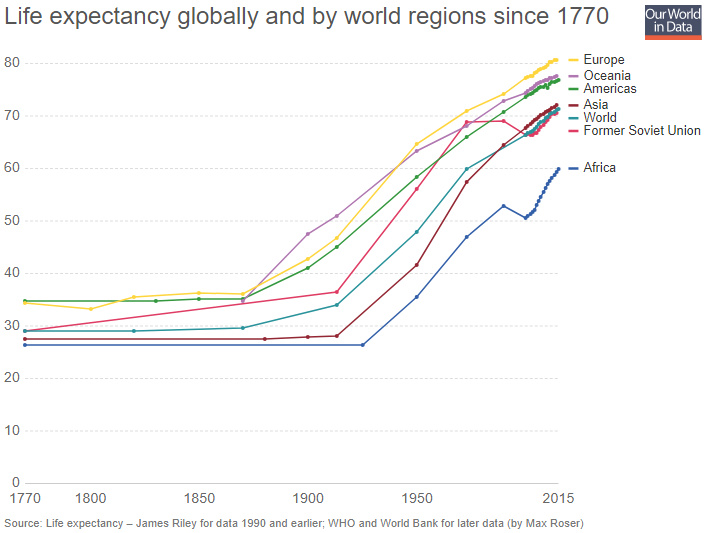The 50 Most Important Life-Saving Breakthroughs in History
For most of civilized history, life expectancy fluctuated in the 30 to 40 year range. Child mortality was all too common, and even for those that made it to adulthood, a long and healthy life was anything but guaranteed. Sanitation was poor, disease was rampant, and many medical practices were based primarily on superstition or guesswork. By the 20th century, an explosion in new technologies, treatments, and other science-backed practices helped to increase global life expectancy at an unprecedented rate. From 1900 to 2015, global life expectancy more than doubled, shooting well past the 70 year mark.
Important Breakthroughs
What were the major innovations that made the last century so very fruitful in saving lives? Today’s infographic from AperionCare highlights the top 50 breakthroughs, ranging from pasteurization to the bifurcated needle, that have helped propel global life expectancy upwards. Interestingly, while many of these innovations have some linkage to the medical realm, there are also breakthroughs in sectors like energy, sanitation, and agriculture that have helped us lead longer and healthier lives. To see innovations on an individual basis, AperionCare breaks them down further as follows:
The breakthroughs that are credited with saving the most lives? Toilets, synthetic fertilizers, blood transfusions, the green revolution (also known as the “Third Agricultural Revolution”), and vaccines are each credited with saving 1 billion lives. Meanwhile, pasteurization, water chlorination, antibiotics, antimalarial drugs, and the bifurcated needle have saved hundreds of millions of lives each. There are also some unusual entries to the list. It turns out that satellites have actually saved 250,000 lives, thanks to the ability to better forecast natural disasters. Nuclear power also gets a shout out – and it may surprise some people that nuclear energy is the least deadly form of energy per kilowatt generated.
Progress in Life Expectancy
For a graphical look at how this all has impacted life expectancy, the following chart from Our World in Data makes a very clear case:
The impact from these new technologies was first experienced in Europe at the end of the 1800s – and other continents quickly saw the benefits thereafter. Impressively, Africa has now passed the 60 year mark in life expectancy, with numbers still rising. on But fast forward to the end of last week, and SVB was shuttered by regulators after a panic-induced bank run. So, how exactly did this happen? We dig in below.
Road to a Bank Run
SVB and its customers generally thrived during the low interest rate era, but as rates rose, SVB found itself more exposed to risk than a typical bank. Even so, at the end of 2022, the bank’s balance sheet showed no cause for alarm.
As well, the bank was viewed positively in a number of places. Most Wall Street analyst ratings were overwhelmingly positive on the bank’s stock, and Forbes had just added the bank to its Financial All-Stars list. Outward signs of trouble emerged on Wednesday, March 8th, when SVB surprised investors with news that the bank needed to raise more than $2 billion to shore up its balance sheet. The reaction from prominent venture capitalists was not positive, with Coatue Management, Union Square Ventures, and Peter Thiel’s Founders Fund moving to limit exposure to the 40-year-old bank. The influence of these firms is believed to have added fuel to the fire, and a bank run ensued. Also influencing decision making was the fact that SVB had the highest percentage of uninsured domestic deposits of all big banks. These totaled nearly $152 billion, or about 97% of all deposits. By the end of the day, customers had tried to withdraw $42 billion in deposits.
What Triggered the SVB Collapse?
While the collapse of SVB took place over the course of 44 hours, its roots trace back to the early pandemic years. In 2021, U.S. venture capital-backed companies raised a record $330 billion—double the amount seen in 2020. At the time, interest rates were at rock-bottom levels to help buoy the economy. Matt Levine sums up the situation well: “When interest rates are low everywhere, a dollar in 20 years is about as good as a dollar today, so a startup whose business model is “we will lose money for a decade building artificial intelligence, and then rake in lots of money in the far future” sounds pretty good. When interest rates are higher, a dollar today is better than a dollar tomorrow, so investors want cash flows. When interest rates were low for a long time, and suddenly become high, all the money that was rushing to your customers is suddenly cut off.” Source: Pitchbook Why is this important? During this time, SVB received billions of dollars from these venture-backed clients. In one year alone, their deposits increased 100%. They took these funds and invested them in longer-term bonds. As a result, this created a dangerous trap as the company expected rates would remain low. During this time, SVB invested in bonds at the top of the market. As interest rates rose higher and bond prices declined, SVB started taking major losses on their long-term bond holdings.
Losses Fueling a Liquidity Crunch
When SVB reported its fourth quarter results in early 2023, Moody’s Investor Service, a credit rating agency took notice. In early March, it said that SVB was at high risk for a downgrade due to its significant unrealized losses. In response, SVB looked to sell $2 billion of its investments at a loss to help boost liquidity for its struggling balance sheet. Soon, more hedge funds and venture investors realized SVB could be on thin ice. Depositors withdrew funds in droves, spurring a liquidity squeeze and prompting California regulators and the FDIC to step in and shut down the bank.
What Happens Now?
While much of SVB’s activity was focused on the tech sector, the bank’s shocking collapse has rattled a financial sector that is already on edge.
The four biggest U.S. banks lost a combined $52 billion the day before the SVB collapse. On Friday, other banking stocks saw double-digit drops, including Signature Bank (-23%), First Republic (-15%), and Silvergate Capital (-11%).
Source: Morningstar Direct. *Represents March 9 data, trading halted on March 10.
When the dust settles, it’s hard to predict the ripple effects that will emerge from this dramatic event. For investors, the Secretary of the Treasury Janet Yellen announced confidence in the banking system remaining resilient, noting that regulators have the proper tools in response to the issue.
But others have seen trouble brewing as far back as 2020 (or earlier) when commercial banking assets were skyrocketing and banks were buying bonds when rates were low.
















